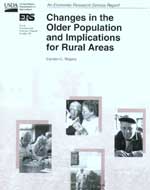Changes in the Older Population and Implications for Rural Areas
- by Carolyn Rogers
- 2/1/2000
Overview
The older population in the United States has been growing and aging rapidly, with the fastest growing segment being the oldest old--those age 85 and older. This segment of the older population increased 37 percent between 1980 and 1990, compared with a 17-percent increase in the total population of elderly (60 and above). The oldest old are more likely to be women, to be in poor health, to live alone, and to be poor. This analysis presents data on changes in the age distribution and socioeconomic status of the older population by rural-urban residence and examines the implications for resources, services, and programs in rural areas.
Download
-
Entire report
Download PDF -
Front Matter (Title Page, Acknowledgments, Contents, and Summary)
Download PDF -
Introduction
Download PDF -
Data and Definitions
Download PDF -
Changes in the Population Age 60 and Older, by Age and Residence
Download PDF -
The Rural-Urban Continuum
Download PDF -
Changes in Economic Status of Persons 60 and Older, by Residence
Download PDF -
Social and Economic Well-Being of the Older Population
Download PDF -
Implications for the Future
Download PDF -
References
Download PDF -
Appendix Tables
Download PDF


